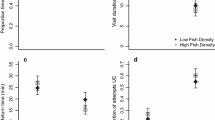Summary
The introduction of game-theoretical thinking into evolutionary biology has laid the groundwork for a heuristic view of animal behaviour in which individuals employ ‘strategies’ — rules that instruct them how to behave in a given circumstance to maximize relative fitness. Axelrod and Hamilton (1981) found that a strategy called Tit-For-Tat (TFT) is one robust cooperative solution to the iterated Prisoner's Dilemma game. There exists, however, little empirical evidence that animals employ TFT. Predator inspection in fish provides one ecological context in which to examine the use of the TFT strategy.
Here we describe a study in which guppies were tested in multiple predator inspection trials. An individual was tested with its mirror images as well as a series of live conspecifics. Results indicate that guppies are capable of recognizing and remembering their partner's behaviour and seem to employ TFT-like strategies over the course of many inspection visits. In addition, significant differences exist between individuals in the degree to which they will inspect a predator, suggesting that ‘cooperator’ and ‘defector’ may be relative terms rather than discrete categories of behaviour.
Similar content being viewed by others
References
Axelrod, R. and Hamilton, W. D. (1981) The evolution of cooperation.Science 211, 1390–6.
Boyd, R. (1989) Mistakes allow evolutionary stability in the repeated Prisoner's Dilemma game.J. Theo. Biol. 136, 47–56.
Boyd, R. and Lorberbaum, J. (1987) No pure strategy is evolutionarily stable in the repeated Prisoner's Dilemma.Nature 327, 58–9.
Boyd, R. and Richerson, P. (1988) The evolution of reciprocity in sizable groups.J. Theo. Biol. 132, 337–56.
Brown, J., Michod, R. and Sanderson, M. (1982) Evolution of social behaviour by reciprocation.J. Theo. Biol. 99, 319–39.
Dugatkin, L. A. (1988) Do guppies play TIT FOR TAT during predator inspection vistts?Behav. Ecol. Sociobiol. 25, 329–99.
Dugatkin, L. A. (1990) N-person games and the evolution of cooperation: a model based on predator inspection behaviour in fish.J. Theo. Biol. 142, 123–35.
Dugatkin, L. A. (1991a) Predator inspection, TIT FOR TAT and shoaling: a comment on Masters and Waite.Anim. Behav. (in press).
Dugatkin, L. A. (1991b) The dynamics of the TIT FOR TAT strategy during predator inspection in the guppy.Behav. Ecol. Sociobiol. (in press).
Dugatkin, L. A. and Alfieri, M. (1991) Guppies and the TIT FOR TAT strategy: preference based on past interaction.Behav. Ecol. Sociobiol. (in press).
Dugatkin, L. A. and Wilson, D. S. (1991) Rover: a strategy for exploiting cooperators in a patchy environment.Am. Nat. (in press).
Feldman, M. and Thomas, E. (1987) Behavior dependent contexts for repeated plays of the Prisoner's Dilemma II: Dynamical aspects of the evolution of cooperation.J. Theo. Biol. 128, 297–315.
George, C. (1960) Behavioral interactions between the pickerel and the mosquitofish. Ph.D. thesis, Harvard University.
Hamilton, W. D. (1971) Geometry of the selfish herd.J. Theo. Bio. 31, 295–311.
Helfman, G. (1989) Threat sensitive avoidance in damselfish-trumpetfish interactions.Behav. Ecol. Sociobiol. 24, 47–58.
Lazarus, J. and Metcalfe, N. (1990) Tit-for-tat cooperation in sticklebacks: a critique of Milinski.Anim. Behav. 39, 987–9.
Magurran, A. (1986) Predator inspection behaviour in minnow shoals: differences between populations and individuals.Behav. Ecol. Sociobiol. 19, 267–3.
Magurran, A. and Higgam, A. (1988) Information transfer across fish shoals under predator threat.Ethology 78, 153–8.
Masters, M. and Waite, M. (1990) Tit-for-tat during predator inspection or shoaling?Anim. Behav. 39, 603–5.
Michod, R. and Sanderson, M. (1985) Behavioural structure and the evolution of cooperation. InEvolution-Essays in honor of John Maynard Smith. Greenwood, J. and Slatkin, M., eds. pp. 95–104. Cambridge: Cambridge University Press.
Milinski, M. (1987) TIT FOR TAT and the evolution of cooperation in sticklebacks.Nature 325, 433–5.
Milinski, M. (1990) No alternative to Tit-for-tat cooperation in sticklebacks.Anim. Behav. 39, 989–91.
Milinski, M., Kulling, D. and Kettler, R. (1990a) Tit for Tat: sticklebacks ‘trusting’ a cooperating partner.Behav. Ecol. 1, 7–11.
Milinski, M., Pfluger, D., Kulling, D. and Kettler, R. (1990b) Do sticklebacks cooperate repeatedly in reciprocal pairs?Behav. Ecol. Sociobiol. 27, 17–21.
Peck, J. and Feldman, M. (1986) The evolution of helping behaviour in a large randomly mixed population.Am. Nat. 127, 209–21.
Pitcher, T. J., Green, D. and Magurran, A. (1986) Dicing with death: predator inspection behavior.J. Fish Biol. 28, 439–48.
Seghers, B. (1973) An analysis of geographic variation in the anti-predator behaviour of the guppy. Ph.D. Thesis, University of British Columbia, British Columbia, Canada.
Author information
Authors and Affiliations
Rights and permissions
About this article
Cite this article
Dugatkin, L.A., Alfieri, M. Tit-For-Tat in guppies (Poecilia reticulata): the relative nature of cooperation and defection during predator inspection. Evol Ecol 5, 300–309 (1991). https://doi.org/10.1007/BF02214234
Issue Date:
DOI: https://doi.org/10.1007/BF02214234




